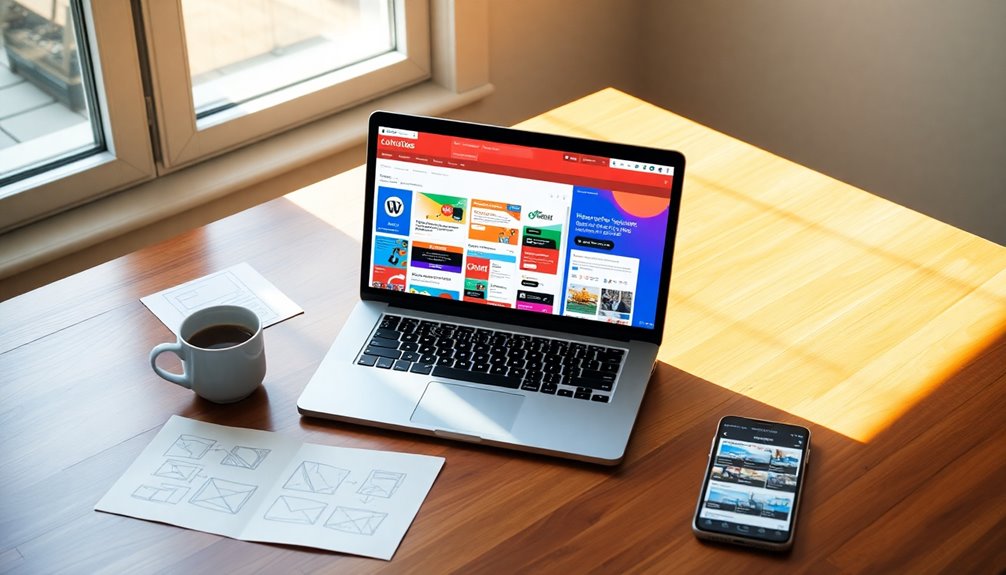Leveraging WordPress widgets is a smart way to boost your site's functionality and user engagement effortlessly. With various types like recent posts, social media feeds, and navigation menus, you can customize your site layout and keep content fresh. Easily place widgets in sidebars or footers to enhance navigation and encourage exploration. Don't forget the importance of mobile responsiveness; your widgets should look great on any device. By regularly updating content and strategically testing placements, you'll greatly improve user satisfaction. Explore further to discover how you can maximize the impact of widgets for your website.
Understanding WordPress Widgets
WordPress widgets are vital tools that enrich your website's functionality without the need for coding. These modular components let you add features to designated widget areas like sidebars and footers, directly from your WordPress dashboard. By dragging and dropping widgets, you can easily customize settings to enhance functionality and improve user experience. Utilizing SEO optimization plugins can further enhance the effectiveness of your widgets by improving visibility and search rankings.
Widgets support various functionalities, such as search bars, recent posts, and navigation menus, which keep your visitors engaged. The strategic positioning of these widgets is essential; their placement can greatly impact site navigation and accessibility. When you select and arrange widgets thoughtfully, you can boost user engagement and retention. Additionally, implementing dynamic sidebar selection can allow for tailored content delivery based on user preferences.
For more specialized needs, you can explore custom widgets. Utilizing WordPress's Widget API, you can develop unique functionalities tailored to your specific website goals, allowing you to add features that meet your audience's demands. Additionally, implementing Call to Action widgets can significantly enhance user engagement by directing visitors toward desired actions.
As a website owner, mastering WordPress widgets guarantees your site performs at its best. By leveraging these tools effectively, you can create a more interactive and enjoyable experience for your visitors, ultimately leading to a more successful website.
Types of WordPress Widgets
There are several types of widgets available that can enhance your website's functionality and user experience. One versatile option is the Text Widget, which lets you add custom text, HTML, or shortcodes in widget areas. This flexibility allows you to display various content types effectively. Additionally, incorporating form builder plugins can streamline the process of collecting user information.
Next, consider Navigation Menu Widgets. They provide a convenient way to display your site's menus in sidebars or footers, which can greatly improve navigation for your visitors.
The Recent Posts Widget is another essential tool, automatically showcasing the latest blog posts to keep your audience engaged with fresh content.
If you want to boost user interaction, Social Media Widgets are a great choice. These integrate feeds from platforms like Twitter and Facebook, so you can display real-time updates directly on your site.
Finally, Search Bar Widgets facilitate quick searches, improving user experience by helping visitors easily find the information they need. Additionally, using widgets effectively can contribute to enhanced site speed and overall performance, which are crucial factors for SEO success.
Benefits of Using Widgets

Using widgets can considerably boost user engagement on your site by making content more accessible and interactive. They also enhance site navigation, allowing visitors to find important information quickly and easily. Additionally, easy navigation enhances user satisfaction and reduces bounce rates. Furthermore, a well-structured design with consistent margins and paddings contributes to a more polished user experience. Implementing responsive design ensures that your widgets function seamlessly across all devices, further improving user interaction and satisfaction.
Improved User Engagement
Widgets can transform your website from a static page into an interactive experience, greatly boosting user engagement. By incorporating widgets like recent posts and social media feeds, you encourage visitors to explore more content on your WordPress site, keeping them engaged longer.
Call-to-action widgets can notably improve performance by prompting users to take specific actions, such as signing up for newsletters or making purchases.
The strategic placement of these widgets in prominent areas, such as sidebars and footers, enhances functionality by increasing visibility and guiding users to important information. Additionally, interactive widgets, like comment sections and contact forms, foster user interaction and communication, turning passive visitors into active participants.
Analytics tracking often reveals that sites with engaging widgets enjoy longer visitor dwell times and lower bounce rates. This indicates that well-implemented widgets play a vital role in retaining users.
Enhanced Site Navigation
Enhancing site guidance is another considerable advantage of incorporating widgets into your WordPress site. By using various WordPress widgets, you can create a more intuitive and user-friendly experience for your visitors, encouraging them to explore your content more thoroughly.
- Navigation Menu: Easily guide users through different sections of your site.
- Recent Posts widget: Showcase the latest site activity, keeping visitors engaged and prompting them to browse more.
- Search Bar widget: Allow users to quickly find specific content without guiding through multiple pages.
- Social Media Widgets: Integrate links to your social media platforms, promoting user interaction and seamless guidance.
Incorporating a Categories List helps visitors find relevant topics quickly, enhancing site guidance.
Meanwhile, Call to Action Widgets direct users to essential areas like promotional offers or newsletter sign-ups, boosting both guidance and conversion opportunities.
With these tools, you can considerably improve user experience, ensuring that your visitors enjoy a smooth and engaging journey through your site.
Custom Widget Creation
When you're ready to create a custom widget in WordPress, the process starts with defining a class that extends the 'WP_Widget' class. This class must include essential methods like '__construct()', 'widget()', 'form()', and 'update()' to guarantee full functionality.
In your theme's 'functions.php' file, you'll call the 'register_widget()' function to register your new widget, making it available within the Widgets admin area.
You can leverage the 'form()' method to add settings that allow users to customize options such as titles and display formats directly in the admin area. Additionally, implementing regular backups is crucial to ensure that your widget remains secure from potential vulnerabilities.
It's vital to implement the 'update()' method to save these widget settings to the database, guaranteeing persistent customization across sessions. Additionally, ensuring that your widget settings are stored securely can help prevent unauthorized access to database credentials, which is crucial for maintaining the integrity of your site.
For added visual appeal, don't forget to enqueue a separate CSS file for your custom widget to apply custom styling. This file should be linked in your plugin to guarantee it loads correctly with the widget.
Effective Widget Placement

Placing widgets strategically on your WordPress site can greatly influence user engagement and overall experience. Effective widget placement not only enhances user experience but also keeps visitors on your site longer.
Here are some tips for optimizing your widget layouts:
- Utilize footer widgets for essential information like sitemaps and contact details to improve site navigation. Additionally, using regular updates ensures that your widgets remain functional and secure, as regular backups can help you recover lost widget configurations.
- Focus sidebar widgets on page-related content to encourage engaging visitors and retain their attention.
- Ensure mobile responsiveness of your widget layouts, especially since over 50% of web traffic comes from mobile devices.
- Conduct A/B testing to find out which widget placements yield the best performance and user interaction.
Additionally, consider incorporating performance optimization techniques to enhance the loading speed of your widgets, ensuring a seamless experience for users.
Enhancing User Experience
Widgets consistently play an essential role in boosting user experience on your WordPress site. They provide significant tools like search bars, recent posts, and social media feeds, making it easy for your visitors to navigate and engage with your content.
By incorporating custom widgets, you can enhance interactivity through features such as contact forms and image galleries, which encourage direct communication and visual appeal.
Strategically placing widgets in sidebars and footers guides users to important information, improving accessibility and reducing bounce rates. This thoughtful arrangement not only enhances functionality but also keeps your audience engaged.
Don't forget to utilize analytics to track widget performance; this data can help you make informed adjustments that further improve user engagement and satisfaction.
Additionally, make certain your widgets are mobile-responsive. A seamless experience across devices is essential for catering to mobile users, as it maintains both functionality and aesthetics. Moreover, selecting a lightweight theme can further enhance the overall performance of your site, ensuring that widgets load quickly and efficiently.
Performance Optimization Strategies

Optimizing performance is key to maintaining an engaging WordPress site, especially after enhancing user experience through effective widget use. By implementing a few strategies, you can greatly boost your site's performance and keep visitors coming back.
- Use caching plugins to reduce load times for your widgets, which improves overall site performance and user experience.
- Strategically position search widgets to enhance navigation, allowing users to quickly find relevant content and engage more deeply with your site.
- Regularly update and optimize media widgets by compressing images, ensuring faster load times that positively affect both site speed and SEO.
- Conduct A/B testing to experiment with different widget placements, helping you identify the most effective configurations for boosting user interaction and conversion rates.
Mobile Responsiveness Considerations
Making your WordPress widgets mobile-responsive is essential for delivering a seamless user experience on various devices. To achieve this, you need to focus on flexible layouts and utilize media queries that adapt widget sizes and positions based on different screen dimensions. This approach enhances mobile responsiveness and guarantees your widgets function without requiring horizontal scrolling or excessive zooming.
You should also implement CSS classes and custom styles tailored for mobile views. This helps optimize the visual appeal and usability of your widgets on smaller screens, making interactions intuitive.
Additionally, consider leveraging responsive design frameworks, like Bootstrap, which can simplify the process of creating widgets that automatically adjust to various screen sizes.
Don't forget to conduct thorough testing across devices to guarantee your widgets resize properly and maintain their functionality. Regularly reviewing widget performance and user engagement metrics on mobile devices will provide valuable insights for any necessary adjustments, guaranteeing your widgets remain effective and user-friendly in a mobile context.
Best Practices for Widget Use

When it comes to enhancing your WordPress site's functionality, implementing best practices for widget use can make a significant impact. Focus on a few essential widgets that align with your site goals, limiting the active ones to just 2-3 in sidebars. This keeps your site efficient and user-friendly.
Regularly review and update your widget content to maintain relevance, as outdated information can lead to higher bounce rates.
To maximize the effectiveness of your widgets, consider the following best practices:
- Use analytics tools to assess widget performance, ensuring data-driven decisions on which widgets to keep or remove.
- Implement responsive design practices so your widgets adapt seamlessly across all devices, enhancing accessibility.
- Organize widgets logically, placing call-to-action widgets prominently to encourage user interactions and conversions.
- Keep your widgets focused on enhancing the user experience with relevant, engaging content.
Future Trends in Widgets
As we look ahead, the future of WordPress widgets is set to evolve dramatically with several key trends shaping their development.
You'll notice a significant shift in widget utilization, driven by the rise of Website as a Service (WaaS), which enables seamless integration of scalable features without slowing down your site. Mobile responsiveness will become even more vital, especially since mobile traffic now accounts for over 50% of global visits.
Customization options are expanding, allowing advanced widgets to incorporate AI-driven content recommendations tailored to user behavior. This means you can provide a more personalized experience for your visitors.
Social commerce widgets are also on the rise, allowing e-commerce sites to enhance shopping experiences directly through social media channels, which are projected to generate $1.2 trillion in sales by 2025.
To stay competitive, continuous improvement and regular updates of widgets will be necessary to meet evolving user expectations.
You'll need to guarantee compatibility with the latest WordPress updates and adhere to stringent security standards. Embracing these trends will position you to maximize the potential of widgets in enhancing your website's functionality.
Maximizing Widget Impact

Widgets can greatly enhance your website's functionality and user engagement if used strategically. By placing widgets in high-visibility areas like sidebars and footers, you can improve user navigation, leading to longer visits and lower bounce rates.
Customizing your widgets allows for a unique look that aligns with your site's design, further enhancing the user experience.
Here are some effective strategies to maximize widget impact:
- Strategic Placement: Position widgets where users naturally look, like sidebars and footers.
- Content Optimization: Regularly update widget content to keep it relevant, boosting both SEO and user retention.
- Social Media Integration: Use social media feeds to engage visitors and encourage sharing.
- A/B Testing: Test different widget configurations to find the most effective placements for enhancing conversion rates.
Conclusion
Just like a skilled gardener knows how to arrange plants for a vibrant garden, you can cultivate your WordPress site with widgets. By understanding their types and benefits, customizing them, and placing them wisely, you'll create a flourishing digital landscape. As you nurture these tools, watch your site blossom with enhanced functionality and user engagement. Embrace the future of widgets, and let your website thrive like a well-tended garden, attracting visitors with its beauty and utility.



